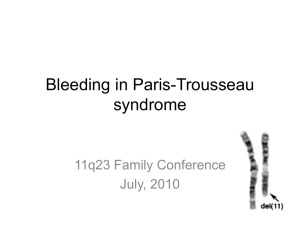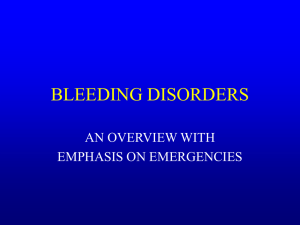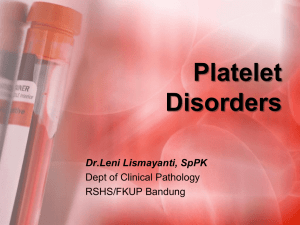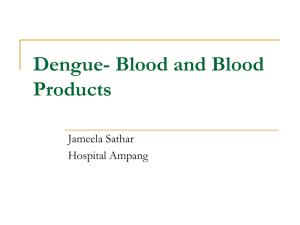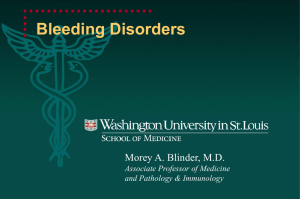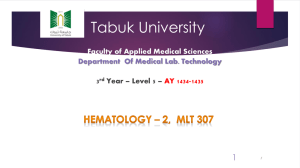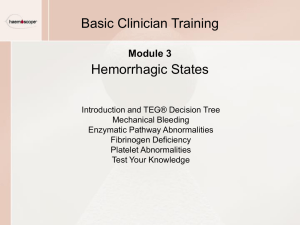Fibrinogen
advertisement
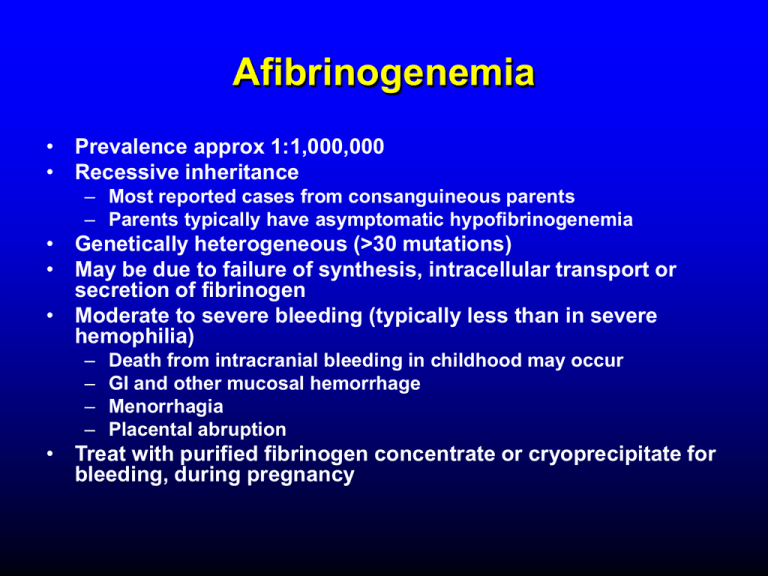
Afibrinogenemia • Prevalence approx 1:1,000,000 • Recessive inheritance – Most reported cases from consanguineous parents – Parents typically have asymptomatic hypofibrinogenemia • Genetically heterogeneous (>30 mutations) • May be due to failure of synthesis, intracellular transport or secretion of fibrinogen • Moderate to severe bleeding (typically less than in severe hemophilia) – – – – Death from intracranial bleeding in childhood may occur GI and other mucosal hemorrhage Menorrhagia Placental abruption • Treat with purified fibrinogen concentrate or cryoprecipitate for bleeding, during pregnancy Inherited dysfibrinogenemia • • • • Prevalance uncertain (most cases asymptomatic) Usually exhibits dominant inheritance Most cases due to missense mutations Mutations may affect fibrin polymerization, fibrinopeptide cleavage, or fibrin stabilization by FXIIIa • Variable clinical manifestations (mutationdependent): – Over 50% asymptomatic – Approx 25% with bleeding tendency (mild to severe) – 20% have a thrombotic tendency (arterial, venous, or both) • Decreased thrombin-binding (antithrombin effect) of fibrin? • Altered fibrin clot structure? Acquired dysfibrinogenemia • • • Usually associated with liver disease – Cirrhosis – Acute hepatitis – Hepatoma Fibrinogen has higher than normal sialic acid content Diseased liver has increased levels of sialyltransferase and other enzymes that control oligosaccharide content JCI 1978;61:535 Diagnosis of dysfibrinogenemia • Prolonged thrombin & reptilase times – PT, aPTT may be prolonged • Disparity (>30%) between fibrinogen activity and antigen • Family testing • Evaluate for liver disease Arch Pathol Lab Med 2002;126:499 Other acquired abnormalities of fibrin formation • • • • High fibrinogen High levels of FDP Myeloma proteins (IgM > IgA > IgG) Autoantibodies Recessively inherited clotting factor deficiencies • Rare – Exceptions: XI, XII deficiency • Homozygotes (often consanguineous parents) or compound heterozygotes • Heterozygous parents usually asymptomatic • Quantitative (“type 1”) deficiency: parallel reduction in antigen and activity • Qualitative (“type 2”) deficiency: reduced activity with near-normal antigen • Genetically heterogeneous • Complete deficiency of II, X not described (lethal?) • Mutation usually in gene encoding clotting factor Exceptions: Combined V, VIII deficiency Combined deficiency of vitamin K-dependent factors Combined deficiency of factors V and VIII • Levels of affected factors 5-20% of normal • Associated with mutations of LMAN-1 (ERGIC-53) or MCFD2, both of which regulate intracellular trafficking of V and VIII Deficiency of multiple vitamin-K dependent clotting factors • Levels of II, VII, IX, X, proteins C and S range from <1% to 30% of normal • Bleeding symptoms proportional to degree of deficiency • Usually associated with missense mutations in vitamin K epoxide reductase subunit 1 (VKORC1) Relative frequencies of recessively inherited factor deficiencies Blood 2004; 104:1243 Clinical features of recessively inherited factor deficiencies Blood 2004; 104:1243 Patterns of bleeding in recessively inherited factor deficiency vs hemophilia Blood 2004; 104:1243 Treatment of rare clotting factor deficiencies • FFP • Prothrombin complex concentrate (II, VII, IX, X) or specific factor concentrate (XIII – others available in Europe) when appropriate • Goal is to maintain “minimal hemostatic levels” • Antifibrinolytic drugs may be helpful in patients with mucosal hemorrhage • Routine prophylaxis appropriate for F XIII deficiency (long half-life, low levels adequate for hemostasis) • Otherwise treatment appropriate for active bleeding or pre-procedure Factor XI XI XIa VIII IX IXa VIIIa V Xa Va Propagation Injury TF VIIa Initiation X PT Xa Thrombin Fibrinogen Fibrin Factor XI deficiency • Recessively inherited • Most common in individuals of Ashkenazi Jewish descent – 2 common mutations (one nonsense, one missense) – Allele frequency as high as 10%, 0.1-0.3% homozygous – Most affected patients compound heterozygotes with low but measurable levels of XI activity • Long aPTT, normal PT – XI activity < 10% in most patients with bleeding tendency Factor XI deficiency Clinical features & treatment • Variable, generally mild bleeding tendency – Bleeding after trauma & surgery – Spontaneous bleeding uncommon – Bleeding risk does not correlate well with XI level • Treatment: FFP – – – – 15 ml/kg loading, 3-6 ml/kg q 12-24h Half life of factor >48 hours Amicar useful after dental extraction, surgery rVIIa is effective but expensive; thrombotic complications reported Factor XIII • Transglutaminase: forms amide bonds between lysine and glutamic acid residues • Heterotetramer (A2B2) in plasma – A chains made by megakaryocytes and monocyte/macrophage precursors – Platelet XIII (50% of total XIII) has only A chains – B chains (non-catalytic) made in liver • Proenzyme activated by thrombin • Crosslinks fibrin Inherited factor XIII deficiency • Autosomal recessive, rare (consanguineous parents) • Heterozygous woman may have higher incidence of spontaneous abortion • Most have absent or defective A subunit • F XIII activity < 1% Inherited factor XIII deficiency Clinical features & treatment • • • • • Bleeding begins in infancy (umbilical cord) Poor wound healing Intracranial hemorrhage Oligospermia, infertility Diagnosis: – Urea solubility test – Quantitative measurement of XIII activity – Rule out acquired deficiency due to autoantibody • F XIII concentrates available (long half life, can administer every 4-6 weeks as prophylaxis) Acquired factor XIII deficiency • Autoantibody-mediated – Very rare • Most patients elderly • May be drug-induced (isoniazid, other antibiotics) • Bleeding may be severe • Diagnosis: – Urea solubility – F XIII activity – Mixing study? Factor XII deficiency • Recessive inheritance, but fairly common • Markedly prolonged aPTT No bleeding tendency • Deficiency of other contact factors (HMWK, prekallikrein) less common, but has similar phenotype PLATELET DISORDERS Platelet structure 1 • Membrane glycoproteins – IIb-IIIa: integrin, cryptic in resting platelet, after platelet activation binds fibrinogen and other adhesive proteins, necessary for aggregation – Ib-IX-V: binds VWF, necessary for platelet adhesion at high shear rates – Ia-IIa: integrin, binds collagen, mediates adhesion at low shear rates and platelet spreading (also acts as receptor) Platelet structure 2 • Membrane receptors – Thrombin receptors (2): cleaved and activated by thrombin – Thromboxane A2 receptor – ADP receptors (3) – Epinephrine receptor – Serotonin receptor – Cytokine, chemokine receptors – Fc receptor Platelet structure 3 • Membrane phospholipids – Procoagulant lipids (phosphatidyl serine) sequestered on inner leaflet, transferred to outer leaflet by “scramblase” enzyme with platelet activation – Arachidonic acid cleaved from inner leaflet by phospholipase, converted to thromboxane by cyclooxygenase & thromboxane synthase Platelet structure 4 • Granules – Dense granules: small molecules involved in platelet activation (ATP/ADP, serotonin) – Alpha granules: fibrinogen, fibronectin, thrombospondin, P-selectin, plasminogen, alpha-2 antiplasmin, factor V, PF4, PDGF, TGF-alpha and beta, ECGF Bernard-Soulier syndrome • Pathophysiology: – Deficiency of platelet membrane glycoprotein Ib-IX (VWF “receptor”) – Defective platelet adhesion • Clinical: Moderate to severe bleeding • Inheritance: autosomal recessive • Morphology: – Giant platelets – Thrombocytopenia (20-100K) • Diagnosis: – No agglutination with ristocetin, decr thrombin response, responses to other agonists intact – Morphology – Decreased GP Ib expression Bernard-Soulier syndrome Glanzmann thrombasthenia • Pathophysiology: – Deficiency of platelet membrane GPIIb-IIIa – Absent platelet aggregation with all agonists; agglutination by ristocetin intact • • • • Clinical: Moderate to severe bleeding Inheritance: autosomal recessive Morphology: normal Diagnosis: – Defective platelet aggregation – Decreased GP IIb-IIIa expression Gray platelet syndrome • • • • Pathophysiology: Empty platelet alpha granules Clinical: Mild bleeding Inheritance: Autosomal dominant or recessive Morphology: – – – – Hypogranular platelets Giant platelets Thrombocytopenia (30-100K) Myelofibrosis in some patients • Diagnosis – Variably abnormal platelet aggregation (can be normal) – Abnormal platelet appearance on blood smear – Electron microscopy showing absent alpha granules Gray platelet syndrome Giant platelet syndromes associated with MYH9 mutations 1. 2. 3. 4. May-Hegglin anomaly Fechtner syndrome Sebastian syndrome Epstein syndrome • All associated with mutations in the non-muscle myosin heavy chain gene MYH9 Thrombocytopenia with giant platelets, but mild bleeding Autosomal dominant inheritance No consistent defects of platelet function detectable in the clinical laboratory Diagnosis usually based on clinical picture, family history, examination of blood smear for neutrophil inclusions • • • • Giant platelet syndromes associated with MYH9 mutations Syndrome MayHegglin Fechtner Sebastian Epstein Neutrophil Hereditary Deafness inclusions nephritis Yes No No Yes Yes Yes Yes* No No No Yes Yes *Neutrophil inclusions have different structure from those in May-Hegglin Neutrophil inclusions in May-Hegglin anomaly Wiskott-Aldrich syndrome • Pathophysiology – Mutation in WASP signaling protein – Decreased secretion and aggregation with multiple agonists; defective T-cell function • Clinical: – Mild to severe bleeding – Eczema, immunodeficiency • Inheritance: X-linked • Morphology: – Thrombocytopenia (20-100K) – Small platelets with few granules • Diagnosis: Family hx, clinical picture, genetic testing Wiskott-Aldrich syndrome Hermansky Pudlak syndrome Chédiak-Higashi syndrome • Pathophysiology: – Platelet dense granule deficiency: decreased aggregation & secretion with multiple agonists – Defective pigmentation – Defective lysosomal function in other cells • Clinical: – Mild to moderate bleeding – Oculocutaneous albinism (HPS) – Lysosomal storage disorder with ceroid deposition, lung & GI disease (HPS) – Immunodeficiency, lymphomas (CHS) • Inheritance: autosomal recessive • Morphology – Reduced dense granules – Abnormal neutrophil granules (CHS) • Diagnosis: clinical picture, neutrophil inclusions (CHS), genetic testing HPS, with oculocutaneous albinism Chédiak-Higashi, showing neutrophil inclusions Hermansky-Pudlak syndrome Br J Haematol 2007;138:671 Disaggregation after primary aggregation with ADP Dense granule deficiency Control platelet Platelet type von Willebrand disease • Pathophysiology: Gain of function mutation in GP Ib, with enhanced binding to VWF and clearance of largest multimers from blood • Clinical: Mild to moderate bleeding • Inheritance: Autosomal dominant • Morphology: Normal, but platelet count often low • Diagnosis: Variably low VWF antigen, disproportionately low ristocetin cofactor activity, loss of largest VWF multimers on electrophoresis, enhanced platelet agglutination by low dose ristocetin (indistinguishable from type 2B VWD) • Can distinguish from 2B VWD by mixing studies with normal/pt platelets and plasma and low dose ristocetin, or by genetic testing Treatment of patients with platelet disorders • • • • Platelet transfusions DDAVP Antifibrinolytic drugs (Amicar) rVIIa? • Treatment decisions must be individualized VASCULAR DISORDERS Hereditary Hemorrhagic Telangiectasia • Autosomal dominant inheritance • Mutation in endoglin gene that controls vascular remodeling – Molecular diagnosis possible • Multiple small AVMs in skin, mouth, GI tract, lungs Endoglin and vascular remodeling J Thromb Haemost 2010;8:1447 Hereditary hemorrhagic telangiectasia J Thromb Haemost 2010;8:1447 Hereditary Hemorrhagic Telangiectasia Clinical features • Epistaxis, GI bleeding – may be severe – Severe iron deficiency common • Pulmonary or CNS bleeding often fatal • Gradual increase in bleeding risk with age • AVMs enlarge during pregnancy • Risk of brain abscess • Hypoxemia from pulmonary HTN and R→L shunting in lung Hereditary Hemorrhagic Telangiectasia Treatment • No consistently effective method for preventing bleeding • Aggressive iron replacement • Antibiotic prophylaxis for dental work etc • Screen for CNS lesions → consider surgical intervention Ehlers-Danlos syndrome • Defective collagen structure – Mutations in genes for various types of collagen • 9 variants – Type IV (mutation in type III collagen gene) most likely to cause bleeding • Bleeding due to weakening of vessel wall → vessel rupture • Conventional tests of hemostatic integrity normal Ehlers-Danlos syndrome • Thin, weak skin with poor healing – “Cigarette paper” scars • Bruising • Hypermobile joints – Spontaneous joint dislocation • Median survival 48 years in type IV EDS – Death from rupture of large vessels or colon perforation


